Metal and Nonmetal Industry Sector
On This Page
Introduction
The following maps, graphs, and tables present data for the Metal and Nonmetal Industry Sector. The information is organized by Mines, Employees, Fatalities, and Injuries. The Mines section contains information on the locations and number of the active mining operations. The Employees section details the number of mine operator employees by county and the number of employee hours by work location. The Fatalities section describes the number of mine operator and contractor fatalities overall and by work location. The Injuries section presents the number of nonfatal lost-time injuries by county, the number by work location, and the number of injuries by accident class. Data source: Mine Safety and Health Administration (MSHA). See Statistical Methodology for further details. Additional Mining Facts for each commodity are available from 2000 through 2015.
Mines
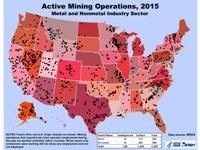 Active Mining Operations, 2015 (Metal and Nonmetal Industry Sector): United States map displaying the locations of active mining operations spotted randomly within counties for the metal and nonmetal industry sector in 2015. Active mines are mining operations that reported mine operator employment during the year. Of the 1,239 metal and nonmetal mines, 136 were underground (92 metal and 44 nonmetal) and 1,103 were surface (223 metal and 880 nonmetal). Mines at which only contractors were working did not show any employment and are not displayed.
Active Mining Operations, 2015 (Metal and Nonmetal Industry Sector): United States map displaying the locations of active mining operations spotted randomly within counties for the metal and nonmetal industry sector in 2015. Active mines are mining operations that reported mine operator employment during the year. Of the 1,239 metal and nonmetal mines, 136 were underground (92 metal and 44 nonmetal) and 1,103 were surface (223 metal and 880 nonmetal). Mines at which only contractors were working did not show any employment and are not displayed.
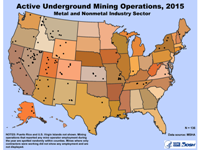 Active Underground Mining Operations, 2015 (Metal and Nonmetal Industry Sector): United States map displaying the locations of active underground mining operations spotted randomly within counties for the metal and nonmetal industry sector in 2015. Active mines are mining operations that reported mine operator employment during the year. There were 136 underground metal and nonmetal mines. Mines at which only contractors were working did not show any employment and are not displayed.
Active Underground Mining Operations, 2015 (Metal and Nonmetal Industry Sector): United States map displaying the locations of active underground mining operations spotted randomly within counties for the metal and nonmetal industry sector in 2015. Active mines are mining operations that reported mine operator employment during the year. There were 136 underground metal and nonmetal mines. Mines at which only contractors were working did not show any employment and are not displayed.
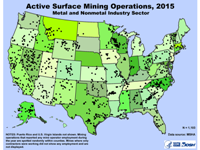 Active Surface Mining Operations, 2015 (Metal and Nonmetal Industry Sector): United States map displaying the locations of active surface mining operations spotted randomly within counties for the metal and nonmetal industry sector in 2015. Active mines are mining operations that reported mine operator employment during the year. There were 1,103 surface metal and nonmetal mines. Mines at which only contractors were working did not show any employment and are not displayed.
Active Surface Mining Operations, 2015 (Metal and Nonmetal Industry Sector): United States map displaying the locations of active surface mining operations spotted randomly within counties for the metal and nonmetal industry sector in 2015. Active mines are mining operations that reported mine operator employment during the year. There were 1,103 surface metal and nonmetal mines. Mines at which only contractors were working did not show any employment and are not displayed.
Employees
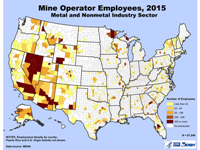 Mine Operator Employees, 2015 (Metal and Nonmetal Industry Sector): Map of the United States displaying employment density by county of the 67,548 mine operator employees in the metal and nonmetal industry sector during 2015. A graduated color ramp is used to symbolize densities of less than 25 employees, 25 to 49 employees, 50 to 199 employees, 200 to 499 employees, and 500 or more employees.
Mine Operator Employees, 2015 (Metal and Nonmetal Industry Sector): Map of the United States displaying employment density by county of the 67,548 mine operator employees in the metal and nonmetal industry sector during 2015. A graduated color ramp is used to symbolize densities of less than 25 employees, 25 to 49 employees, 50 to 199 employees, 200 to 499 employees, and 500 or more employees.
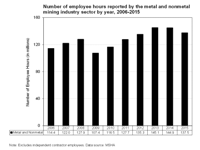 Number of Employee Hours Reported for the Metal and Nonmetal Mining Industry Sector by Year, 2006-2015: Graph displaying the number of mine operator employee hours reported for the metal and nonmetal mining industry from 2006 through 2015. Employee hours increased from 114.4 million in 2006 to 127.9 million hours in 2008. In 2009 the hours reported dropped to107.4 million with a steady increase to 145.1 million hours reported for 2013. In 2015, the hours declined to 137.5 million.
Number of Employee Hours Reported for the Metal and Nonmetal Mining Industry Sector by Year, 2006-2015: Graph displaying the number of mine operator employee hours reported for the metal and nonmetal mining industry from 2006 through 2015. Employee hours increased from 114.4 million in 2006 to 127.9 million hours in 2008. In 2009 the hours reported dropped to107.4 million with a steady increase to 145.1 million hours reported for 2013. In 2015, the hours declined to 137.5 million.
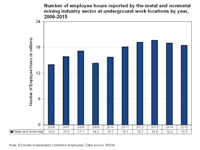 Number of Underground Employee Hours Reported for the Metal and Nonmetal Mining Industry Sector by Year, 2006-2015: Graph displaying the number of underground mine operator employee hours reported for the metal and nonmetal mining industry from 2006 through 2015. The employee hours increased from 14.0 million in 2006 to 17.1 million hours in 2008. In 2009 the hours reported dropped to14.3 million with a steady increase to 19.6 million hours reported for 2013. In 2015, the hours declined to 18.5 million.
Number of Underground Employee Hours Reported for the Metal and Nonmetal Mining Industry Sector by Year, 2006-2015: Graph displaying the number of underground mine operator employee hours reported for the metal and nonmetal mining industry from 2006 through 2015. The employee hours increased from 14.0 million in 2006 to 17.1 million hours in 2008. In 2009 the hours reported dropped to14.3 million with a steady increase to 19.6 million hours reported for 2013. In 2015, the hours declined to 18.5 million.
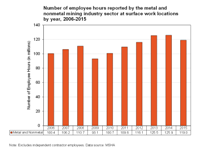 Number of Surface Employee Hours Reported for the Metal and Nonmetal Mining Industry Sector by Year, 2006-2015: Graph displaying the number of surface mine operator employee hours reported for the metal and nonmetal mining industry from 2006 through 2015. The employee hours increased from 100.4 million in 2006 to 110.7 million hours in 2008. In 2009 the hours reported dropped to 93.1 million with a steady increase to 125.9 million hours in 2014. In 2015, there were 119.0 million hours reported.
Number of Surface Employee Hours Reported for the Metal and Nonmetal Mining Industry Sector by Year, 2006-2015: Graph displaying the number of surface mine operator employee hours reported for the metal and nonmetal mining industry from 2006 through 2015. The employee hours increased from 100.4 million in 2006 to 110.7 million hours in 2008. In 2009 the hours reported dropped to 93.1 million with a steady increase to 125.9 million hours in 2014. In 2015, there were 119.0 million hours reported.
Fatalities
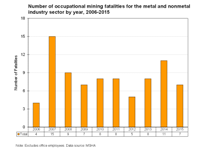 Number of Occupational Mining Fatalities for the Metal and Nonmetal Industry Sector by Year, 2006-2015: Graph displaying the number of occupational fatalities, excluding office employees, from 2006 through 2015 for the metal and nonmetal industry sector. The numbers vary by year with the highest number occurring in 2007 when there were 15 fatalities reported and the lowest number during the period was in 2006 when four fatalities occurred. There were seven fatalities in 2015.
Number of Occupational Mining Fatalities for the Metal and Nonmetal Industry Sector by Year, 2006-2015: Graph displaying the number of occupational fatalities, excluding office employees, from 2006 through 2015 for the metal and nonmetal industry sector. The numbers vary by year with the highest number occurring in 2007 when there were 15 fatalities reported and the lowest number during the period was in 2006 when four fatalities occurred. There were seven fatalities in 2015.
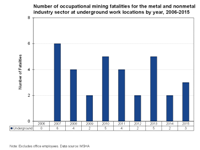 Number of Occupational Mining Fatalities for the Metal and Nonmetal Industry Sector at Underground Work Locations by Year, 2006-2015: Graph displaying the number of occupational mining fatalities, excluding office employees, at underground work locations from 2006 through 2015 for the metal and nonmetal industry sector. The numbers vary by year from a low of zero in 2006, to a high of six fatalities reported in 2007. Three fatalities were reported for 2015.
Number of Occupational Mining Fatalities for the Metal and Nonmetal Industry Sector at Underground Work Locations by Year, 2006-2015: Graph displaying the number of occupational mining fatalities, excluding office employees, at underground work locations from 2006 through 2015 for the metal and nonmetal industry sector. The numbers vary by year from a low of zero in 2006, to a high of six fatalities reported in 2007. Three fatalities were reported for 2015.
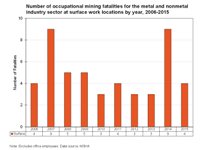 Number of Occupational Mining Fatalities for the Metal and Nonmetal Industry Sector at Surface Work Locations by Year, 2006-2015: Graph displaying the number of occupational mining fatalities, excluding office employees, occurring at surface work locations from 2006 through 2015 for the metal and nonmetal industry sector. The numbers vary by year with the highest number occurring in 2007 and 2014 when nine fatalities are reported. The lowest number was three fatalities reported in 2010, 2012, and 2013. There were four fatalities reported in 2015.
Number of Occupational Mining Fatalities for the Metal and Nonmetal Industry Sector at Surface Work Locations by Year, 2006-2015: Graph displaying the number of occupational mining fatalities, excluding office employees, occurring at surface work locations from 2006 through 2015 for the metal and nonmetal industry sector. The numbers vary by year with the highest number occurring in 2007 and 2014 when nine fatalities are reported. The lowest number was three fatalities reported in 2010, 2012, and 2013. There were four fatalities reported in 2015.
Injuries
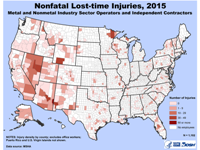 Nonfatal Lost-time Injuries, 2015 (Metal and Nonmetal Industry Sector Operators and Contractors): United States map displaying nonfatal lost-time injury density by county for 1,102 Metal and Nonmetal Industry Sector operator and contractor injuries during 2015. Office workers are excluded. A graduated color ramp is used to symbolize densities of zero injuries, 1 to 9, 10 to 29, 30 to 49, and 50 or more injuries.
Nonfatal Lost-time Injuries, 2015 (Metal and Nonmetal Industry Sector Operators and Contractors): United States map displaying nonfatal lost-time injury density by county for 1,102 Metal and Nonmetal Industry Sector operator and contractor injuries during 2015. Office workers are excluded. A graduated color ramp is used to symbolize densities of zero injuries, 1 to 9, 10 to 29, 30 to 49, and 50 or more injuries.
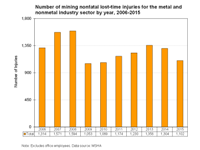 Number of Mining Nonfatal Lost-time Injuries for the Metal and Nonmetal Industry Sector by Year, 2006-2015: Graph displays the number of mining nonfatal lost-time injuries for the metal and nonmetal industry sector, excluding office employees, from 2006 through 2015. The number of injuries has varied over the period from 1,314 in 2006 to 1,102 in 2015. The highest number of 1,594 injuries are reported in 2008 and the lowest number of 1,053 injuries are reported in 2009.
Number of Mining Nonfatal Lost-time Injuries for the Metal and Nonmetal Industry Sector by Year, 2006-2015: Graph displays the number of mining nonfatal lost-time injuries for the metal and nonmetal industry sector, excluding office employees, from 2006 through 2015. The number of injuries has varied over the period from 1,314 in 2006 to 1,102 in 2015. The highest number of 1,594 injuries are reported in 2008 and the lowest number of 1,053 injuries are reported in 2009.
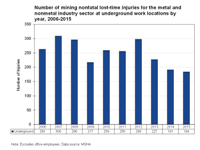 Number of Mining Nonfatal Lost-time Injuries for the Metal and Nonmetal Industry Sector at Underground Work Locations by Year, 2006-2015: Graph displays the number of mining nonfatal lost-time injuries for the metal and nonmetal industry sector, excluding office employees, from 2006 through 2015. The number of injuries varied over the period from 263 in 2006 to 184 in 2015. The year with the highest number of injuries was 2007 reporting 309 nonfatal lost-time injuries.
Number of Mining Nonfatal Lost-time Injuries for the Metal and Nonmetal Industry Sector at Underground Work Locations by Year, 2006-2015: Graph displays the number of mining nonfatal lost-time injuries for the metal and nonmetal industry sector, excluding office employees, from 2006 through 2015. The number of injuries varied over the period from 263 in 2006 to 184 in 2015. The year with the highest number of injuries was 2007 reporting 309 nonfatal lost-time injuries.
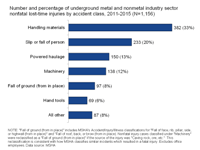 Number and Percentage of Underground Metal and Nonmetal Industry Sector Nonfatal Lost-time Injuries by Accident Class, 2011-2015: Graph displays the distribution of nonfatal lost-time injuries by accident class for the metal and nonmetal industry sector at underground mining locations for the period from 2011 through 2015. Excluding office employees, there were a total of 1,156 lost-time injuries. "Handling materials" accounted for 33%, "Slip or fall of person" 20%, "Powered Haulage" 13%, and "Machinery" had 12% of the nonfatal lost-time injures. "Fall of ground (from in place)," which includes MSHA’s Accident/Injury/Illness Classifications for "Fall of face, rib, pillar, side, or highwall from in place" and "Fall of roof, back, or brow from in place," made up 8% of the nonfatal lost-time injuries. Nonfatal injury cases classified under machinery were reclassified as a fall of ground (from in place) if the source of the injury was caving rock, ore, etc. This reclassification is consistent with how MSHA classifies similar incidents which resulted in a fatal injury. "Hand tools" had 6% and the "All other" category ended with 8% of the nonfatal lost-time injuries during the 5-year period. Note that due to independent rounding, the sum of percentages may not equal 100.
Number and Percentage of Underground Metal and Nonmetal Industry Sector Nonfatal Lost-time Injuries by Accident Class, 2011-2015: Graph displays the distribution of nonfatal lost-time injuries by accident class for the metal and nonmetal industry sector at underground mining locations for the period from 2011 through 2015. Excluding office employees, there were a total of 1,156 lost-time injuries. "Handling materials" accounted for 33%, "Slip or fall of person" 20%, "Powered Haulage" 13%, and "Machinery" had 12% of the nonfatal lost-time injures. "Fall of ground (from in place)," which includes MSHA’s Accident/Injury/Illness Classifications for "Fall of face, rib, pillar, side, or highwall from in place" and "Fall of roof, back, or brow from in place," made up 8% of the nonfatal lost-time injuries. Nonfatal injury cases classified under machinery were reclassified as a fall of ground (from in place) if the source of the injury was caving rock, ore, etc. This reclassification is consistent with how MSHA classifies similar incidents which resulted in a fatal injury. "Hand tools" had 6% and the "All other" category ended with 8% of the nonfatal lost-time injuries during the 5-year period. Note that due to independent rounding, the sum of percentages may not equal 100.
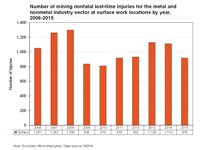 Number of Mining Nonfatal Lost-time Injuries for the Metal and Nonmetal Industry Sector at Surface Work Locations by Year, 2006-2015: Graph displays the number of mining nonfatal lost-time injuries for the metal and nonmetal industry sector, excluding office employees, at surface work locations from 2006 through 2015. The number of nonfatal lost-time injuries varied over the period from 1,051 in 2006 to 918 in 2015. The highest number of injuries occurred in 2008 with 1,298 and the lowest number in 2010 with 810 nonfatal lost-time injuries reported. "Unknown or NEC" had 3%, "Stepping/kneeling on object" had 2%, and the "All other" category had 3% of the nonfatal lost-time injuries during the 5-year period.
Number of Mining Nonfatal Lost-time Injuries for the Metal and Nonmetal Industry Sector at Surface Work Locations by Year, 2006-2015: Graph displays the number of mining nonfatal lost-time injuries for the metal and nonmetal industry sector, excluding office employees, at surface work locations from 2006 through 2015. The number of nonfatal lost-time injuries varied over the period from 1,051 in 2006 to 918 in 2015. The highest number of injuries occurred in 2008 with 1,298 and the lowest number in 2010 with 810 nonfatal lost-time injuries reported. "Unknown or NEC" had 3%, "Stepping/kneeling on object" had 2%, and the "All other" category had 3% of the nonfatal lost-time injuries during the 5-year period.
See Also
- Best Practices for Dust Control in Metal/Nonmetal Mining
- Coal Industry Sector
- Electromagnetic Noise in Lucky Friday Mine
- Mining Fact Sheets
- Mining Facts - 2015
- Novel Stopping Designs for Large-Opening Metal/Nonmetal Mines
- Programmable Electronic Mining Systems: Best Practice Recommendations (In Nine Parts): Part 3: 2.2 Software Safety
- Propagation of EM Signals in Underground Metal/Non-Metal Mines
- Propagation of EM Signals in Underground Metal/Non-Metal Mines: Magma Copper Company - San Manuel Mine
- Statistical Methodology
- Statistics: Metal Operators
- Statistics: Nonmetal Operators
- Stone and Sand & Gravel Industry Sector
- Technology News 491 - NIOSH Releases Two New Safety Training Videos
- Technology News 501 - Measuring Very Low Air Velocities in Underground Metal/Nonmetal Mines
- Page last reviewed: 5/19/2017
- Page last updated: 5/19/2017
- Content source: National Institute for Occupational Safety and Health, Mining Program


 ShareCompartir
ShareCompartir